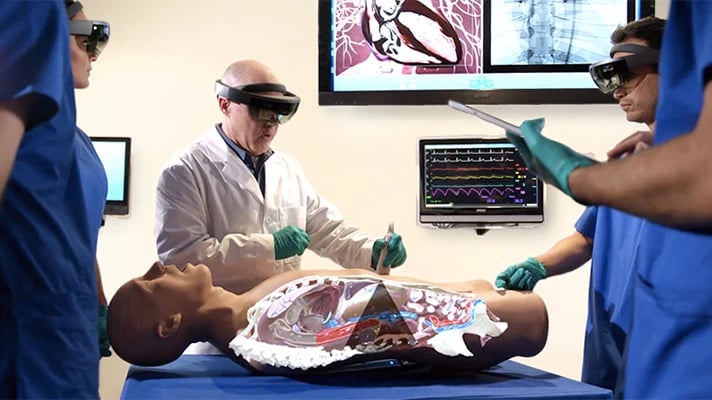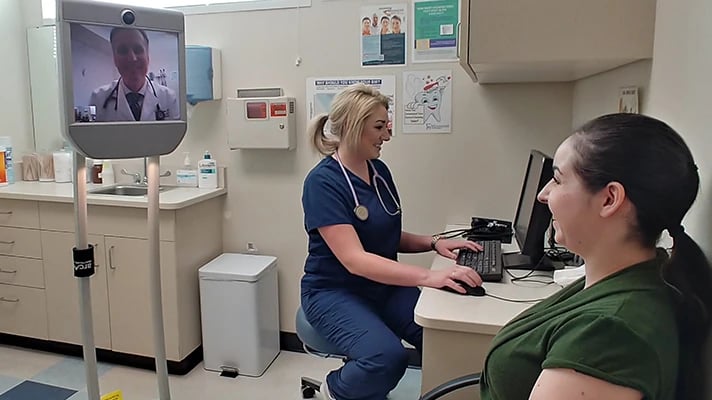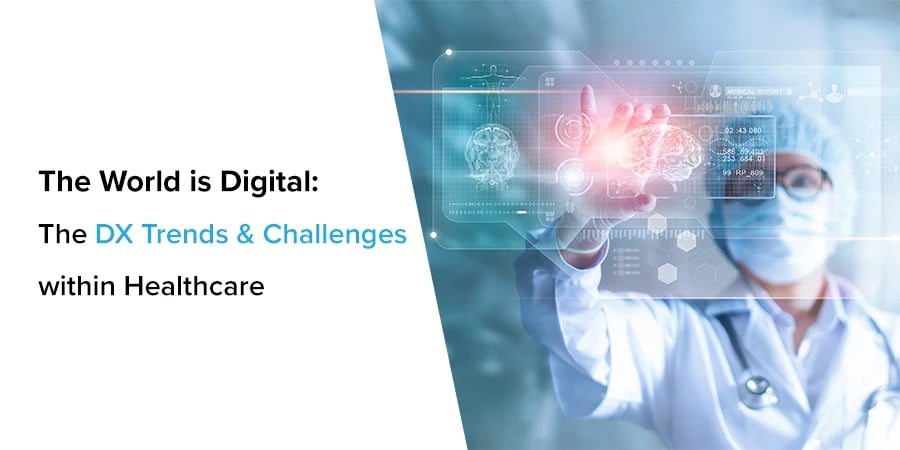The digital transformation of the healthcare industry has the potential to radically improve the ability for doctors, hospitals, and organizations to treat patients and help them live longer, healthier lives.
Let’s take a look at some of the key trends in this digital transformation as well as the challenges that the industry faces today.
Technology Trends in Healthcare
Wearables & Internet of Medical Things
Wearables and the Internet of Medical Things (IoMT) continue to be a major trend in the digital transformation of the healthcare industry.
According to Juniper Research, the healthcare wearable market will be worth $60 billion by 2023. Likewise, by 2021, the global IoMT market will reach $136.8 billion according to Allied Market Research.
These connected devices provide health professionals with a greater ability to capture vital medical data in realtime gaining a richer, more accurate assessment of a patient’s health.
Case Study : How to Test IoMT?
Furthermore, wearables and IoMT are enabling the healthcare industry and patients themselves to gather data and enhance preventive medical endeavors at both the micro and macro levels.
Artificial Intelligence & Data Analytics
In the healthcare industry, officials often have to make a difficult choice between the affordability, accessibility, and effectiveness of their services. In a perfect world, medical care would be completely accessible, affordable, and effective. In the real word, however, that is not the case.
Fortunately, AI has the potential to help the industry become more accessible, affordable, and effective.
AI systems can help lower costs by completing time-consuming tasks that humans once did, which would allow healthcare professionals to focus on more complicated or patient-centered tasks. AI can also be used to enable patients to use self-service terminals when appropriate, allowing clinics or hospitals to use resources in ways that deliver the greatest impact on patients’ health.
According to a study by Accenture, AI systems could meet the 20 percent of unmet clinical demand. Additionally, Accenture predicts that by 2026, top AI applications may save the healthcare industry $150 billion per year.
Moreover, AI systems are being developed to help medical officials analyze vast amounts of data more efficiently. For example, AI software can analyze CAT scans in just seconds, decreasing the amount of time a patient must wait for their results. AI applications like this allow patients to be treated more efficiently, which also goes a long way towards improving their overall experience.
The benefits of AI are being realized by healthcare executives. According to the PWC Health Research Institute, nearly 40 percent of healthcare executives are investing in AI, machine learning, and predictive analytics.
The potential of AI to improve healthcare services is generating enormous amounts of capital to finance this technology. By 2021, the total public and private sector investment in healthcare AI is expected to reach $6.6 billion.
AI has the ability to deliver personalized care as well, especially when it comes to prescribing treatments for patients. For example, AI software can review millions of medical studies to find an effective treatment plan based on a patient’s condition, age, and other important factors.
Augmented Reality and Virtual Reality
Augmented Reality and Virtual Reality are innovative solutions that are revolutionizing the healthcare industry. From 2018 to 2023, the value of the healthcare-based AR and VR industry is expected to increase from $933 million to $3.2 billion.
AR and VR have a number of applications in healthcare that are helping both patients and professionals. VR, for example, is helping medical professionals learn how to perform dangerous procedures without having to place patients at risk. During complexe procedures, AR technology is also being used to help guide surgeons to reduce the chance of mistake.

AR and VR have treatment applications for patients as well. For patients suffering from dementia or Alzheimer's, AR and VR are being used to re-create experiences that allow them to relive a specific memory or general periods in their life that were happy.
VR is also being used to as therapy tool to help patients overcome both painful and traumatic experiences, which can be extremely difficult to cope with. Research has shown that burn patients experience between 35 and 50 percent less pain when engaged in a VR experience.
Telemedicine
A number of innovative solutions are changing the way in which patients interact with health professionals. From finding a doctor to attending the appointment, new solutions are facilitating people’s access to health professionals.
One example of telehealth technology that is improving people's access to healthcare are virtual appointments. For patients located in rural or remote areas, where access to healthcare has been traditionally limited, virtual appointments enable disadvantaged patients to see doctors. Similarly, patients with mobility challenges can also use this technology to see health professionals.

Driven by the benefits, more and more people are turning towards this technology. From 2015 to 2018, the number patients using this technology increased from 1 million to 7 million. By 2021, the global telemedicine industry will be worth more than $66 billion.
Most recently, Doctolib, a major player in the European telemedicine field, raised €150 million in a round of founding. Through their online platforms, Doctolib helps people find and book appointments with general practitioners and specialists. Given the potential of telemedicine as well as their latest round of funding, Doctolib is looking to beef up their platform to facilitate virtual appointments between doctors and their patients.
Overall, the development of various mobile applications and websites are also enabling patients to communicate with doctors and receive the care they need. All of these changes are contributing to more patient empowerment and better service in the industry.
Technology Challenges in Healthcare
Data Processing
A major challenge in the healthcare industry is the processing and analysis of data. Part of the problem is due to the sheer amount of data that hospitals, clinics, and health professionals collect. Without robust AI systems that can analyze this data, it is hard for organizations to deliver better and more personalized care to patients.
Collecting and synchronizing data is another important challenge. With the rise of telemedicine, doctor visits are taking place across multiple channels making it harder to health professionals to update patients’ health records. As a result, it will be vital for the healthcare industry to create a way to record and update health records for both in-person and virtual visits.
Additionally, various legislation like the EU’s General Data Protection Regulation (GDPR) places new requirements on the way organizations can collect, use, and store personal data. Under GDPR, fines can be as large as €20 million or 4% of a company’s annual turnover. Therefore, it is in the best interest for all organizations to respect and follow all of GDPR requirements.
Cybersecurity
Cybersecurity is a challenge in every industry, and healthcare is no different. Organizations must remain extremely vigilant against cyber threats, which can be extremely costly.
For example, a study by IBM revealed that healthcare organizations had the highest costs associated with data breaches, which were three times higher than in other industries.
In healthcare, user authentication deficiencies, endpoint leakage, and excessive user permissions are the three most common vulnerabilities. Taking the appropriate measures to strengthen these areas is essential to the security of the healthcare industry.
Furthermore, the adoption of IoMT and the overall digitalization of the industry will likely lead to more attacks. IoMT devices can pose their challenges when it comes to security-related components, which vendors can stop supporting after a period of time.
Although threats can originate from those looking to do harm, others can result from errors in a product or softwares development. In 2018, a software coding error was blamed for the erroneous distribution of sensitive and confidential information of 150,000 patients in the U.K. Organizations producing software, mobile applications, websites, IoMT devices,etc. must ensure they bugs like this are uncovered before the launch or update of products and systems.
Digital User Experience
Last but not least, designing products like a connected heart monitor, mobile application, or any other digital product or service that function perfectly and are user-friendly is a major challenge.
When it comes to any form of technology, the end user must be taken into consideration in order to produce a product or service that is easy to use. In the healthcare industry this is ultra important since many products will be used by both patients and medical professionals.
An uncomfortable or poorly designed IoMT device, for example, can taint a patient’s experience and cause them to remove the device limiting the data it is able to collect. On the other side, if the software for a IoMT device is difficult to use, it will also limit the overall willingness of medical professionals to use or prescribe the device to other patients.
A lack of standards, especially when it comes to IoMT, make it more difficult for these products and services to function perfectly in an ecosystem of connected devices. Nonetheless, the ability for technology to generate major improvements to the healthcare industry will largely depend on its overall quality.
Quality Assurance Testing in Healthcare
Without a doubt, Quality Assurance (QA) testing plays a key role in the production of any digital product or service, especially in healthcare. QA testing is designed to assess the quality and performance of products or services, which are commonly hindered by software bugs.
Launching a connected medical product or website, for example, that is negatively affected by bugs is a recipe for disaster for the companies that produce them as well as the medical professionals, hospitals, and patients that use them.
Software bugs, regardless of the nature, work to undermine performance and erode confidence in brands and organizations, which is rather challenging to restore. Given the high stakes in the healthcare industry, QA testing is mandatory to any organization’s or product’s success.
Learn more about the latest trends in healthcare or specific testing challenges, please download our white paper: The World is Digital: New technology trends and QA challenges in healthcare.









